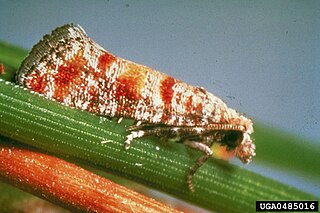
The Tortricidae are a family of moths, commonly known as tortrix moths or leafroller moths, in the order Lepidoptera. This large family has over 11,000 species described, and is the sole member of the superfamily Tortricoidea, although the genus Heliocosma is sometimes placed within this superfamily. Many of these are economically important pests. Olethreutidae is a junior synonym. The typical resting posture is with the wings folded back, producing a rather rounded profile.

Archips oporana, also known as the pine tortrix or spruce tortrix is a moth of the family Tortricidae, found in Asia and Europe. It was first described by Carl Linnaeus in 1758.

Rhyacionia buoliana, the pine shoot moth, is a moth of the family Tortricidae. It is native to North Africa, North Asia, and Europe, and invasive in North America and South America.

Protoboarmia porcelaria, the porcelain gray or dash-lined looper, is a Geometrid species of moth found throughout North America, except in the far north. The species was first described by Achille Guenée in 1857.

Rhyacionia duplana, the summer shoot moth or Elgin shoot moth when referring to subspecies logaea, is a moth of the family Tortricidae. It is found from northern and central Europe to eastern Russia, China and Japan. It has also been reported from Korea, but it has not been found in recent studies.

Rhyacionia pinicolana is a moth of the family Tortricidae. It is found from northern and central Europe to eastern Russia, China, Japan and Korea.

Rhyacionia pinivorana, the spotted shoot moth, is a moth of the family Tortricidae. It is found from northern and central Europe to eastern Russia, China, Korea and Japan.

Rhyacionia frustrana, the Nantucket pine tip moth, is a moth of the family Tortricidae. It is found in the United States from Massachusetts south to Florida, west to Missouri, Oklahoma, Texas and California. It is also found in the Dominican Republic, Cuba, Jamaica, Mexico (Oaxaca), Guatemala, Honduras and Nicaragua.

Eucosma sonomana, the western pineshoot borer, is a moth of the family Tortricidae. It is found in western North America.
Coleotechnites ponderosae, the ponderosa pine needleminer, is a moth of the family Gelechiidae. It is found in the United States, where it has been recorded from Colorado.
Coleotechnites edulicola is a moth of the family Gelechiidae. It is found in North America, where it has been recorded from New Mexico and southern Utah and possibly Colorado.

Rhyacionia adana, the Adana tip moth, is a moth of the family Tortricidae. It is found in north-eastern North America, including Massachusetts, Pennsylvania, Virginia, Michigan, Wisconsin and Ontario.
Eucosma gloriola, the eastern pine shoot borer, is a moth of the family Tortricidae. It is found from eastern Canada, south to Virginia, and west to Minnesota.

Epinotia radicana, the red-striped needleworm moth, is a species of moth of the family Tortricidae. It is found in western Canada, including British Columbia and the Alberta.

Rhyacionia subtropica, the subtropical pine tip moth, is a species of moth of the family Tortricidae. It is found in the United States in southern Alabama and Florida. It has also been recorded from Cuba and Belize.

Exoteleia dodecella, the pine bud moth, is a moth of the family Gelechiidae. It is widely distributed from western Europe to Siberia. It is an introduced species in North America.
Eupinivora ponderosae is a species of moth of the family Tortricidae. It is found in the montane regions of the western United States from Nevada, Utah, Wyoming and Colorado, south to Arizona and New Mexico and east to Texas. The habitat consists of conifer-dominated areas at elevations ranging from 1,700 to 2,700 meters.

Argyrotaenia tabulana, the jack pine tube moth or lodgepole needletier moth, is a species of moth of the family Tortricidae. It is found in North America, where it has been recorded from Alabama, Arkansas, British Columbia, Florida, Georgia, Indiana, Louisiana, Maine, Maryland, Massachusetts, Mississippi, New Jersey, New York, North Carolina, Ohio, Oklahoma, Pennsylvania, South Carolina and West Virginia.
Exoteleia anomala, the ponderoa pine needle miner, is a moth of the family Gelechiidae. It is found in the United States, where it has been recorded from Alabama, Louisiana, Mississippi, New Mexico and Arizona.














